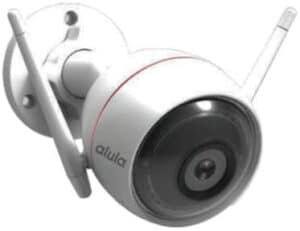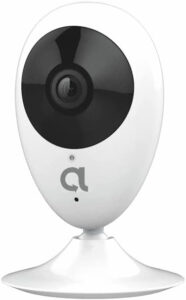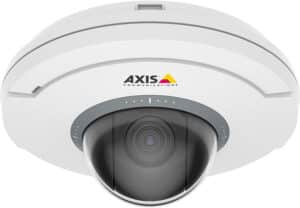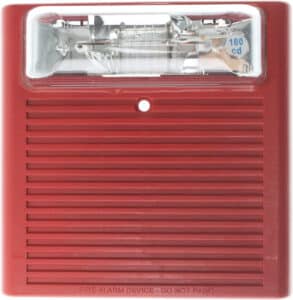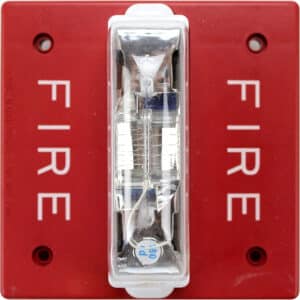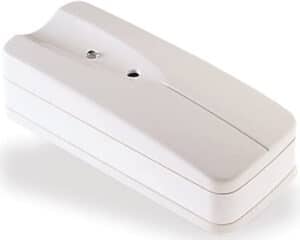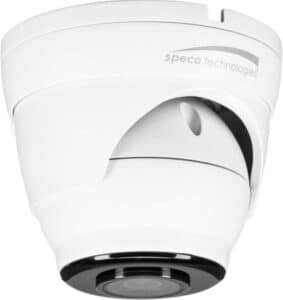Outdoor Security Camera Buying Guide: How to Choose the Right One
With the dawn of the digital age, security cameras have not only become more affordable and widespread, but smarter as well. External cameras can be a real deterrent to would-be burglars. While they do require proper installation, they are an excellent way of monitoring the exterior of your home.
The added visibility provided by security cameras can be seen today as a positive trend for homeowners who want to protect their property. With burglars becoming increasingly bold and brazen, homeowners have to resort to more technologically advanced methods to protect their property.
If you are in the market for a new security camera, this outdoor security camera buying guide will help make the process of selecting the right one for you easier.
Table of Contents
Types of Outdoor Security Cameras
There are several types of security cameras available in the market, each with its own set of features and benefits. Some of the most popular types include:
Wired Security Cameras
Wired cameras are connected to a power source and a video recorder using cables. These cameras offer a reliable and stable connection, making them suitable for large properties or areas with weak wireless signals. However, they can be challenging to install, and the presence of cables may not be aesthetically pleasing.
Wireless Security Cameras
Wireless security cameras, as the name suggests, do not require cables for power or video transmission. Instead, they rely on a Wi-Fi connection to transmit video footage to a local storage device or the cloud. These cameras are easy to install, but their performance may be affected by the strength of the internet connection.
Ring Cameras
Ring cameras are a popular choice for homeowners, as they integrate seamlessly with other Ring products such as doorbells and security systems. These cameras offer features such as motion detection, two-way audio, and cloud storage. Ring cameras require a subscription for professional monitoring and access to cloud storage.
Dome Cameras
Dome cameras are an ideal choice for indoor surveillance and outdoor surveillance, as they are discreet and hard to tamper with. These cameras are usually wired, but some models are available with a wireless connection. Dome cameras are generally more expensive than other types of security cameras and are often used in business settings.
Bullet Cameras
Bullet cameras are a popular choice for outdoor security, as they offer a wide field of view and are weather-resistant. These cameras are usually wired and have night vision capability. Bullet cameras are relatively easy to install and can be used for both residential and commercial applications.
Security Camera Features to Look For
When choosing the right security camera, it is essential to consider the features that are most important to your specific needs. Some of the key features to consider include:
Video Quality
Video quality is a crucial factor in selecting a security camera, as it determines the clarity of the footage captured. Cameras with a high video resolution, such as 1080p or 4K, will provide clearer and more detailed images. This can be especially important for identifying faces or license plates in the event of a security breach.
Field of View
The field of view (FOV) of a security camera refers to the angle of view that the camera can capture. Cameras with a wider FOV offer better coverage of an area and can detect motion more easily.
Color Night Vision
Most security cameras come with infrared night vision, which captures black-and-white footage in low-light conditions. However, some cameras offer color night vision, providing more detailed and accurate images even at night. This can be particularly useful for identifying important details such as clothing colors or vehicle colors during an incident.
Local Storage vs. Cloud Storage
Security cameras can store footage either locally on a storage device or in the cloud. Local storage is more cost-effective and does not require an internet connection. However, it may be susceptible to theft or damage, and the storage capacity may be limited. Cloud storage, on the other hand, offers unlimited storage and remote access to footage, but it typically requires a monthly subscription fee.
Cloud Storage Plans
Most security camera providers offer cloud storage plans that allow users to store and access footage remotely. These plans usually offer different levels of storage, with larger plans offering more storage capacity. Some also offer features such as motion detection and facial recognition. Prices vary depending on the plan and provider, but they typically range from $5 to $30 per month.
Camera Lens Types
Security cameras typically come with a variety of lens types, including fixed, varifocal, and wide-angle lenses. Fixed lenses are the simplest, providing a fixed field of view. Varifocal lenses allow users to adjust the field of view, while wide-angle lenses provide a wider view of the area being monitored. The type of lens used depends on the environment and the desired coverage area.
Two-Way Audio
Two-way audio allows you to communicate with people on your property through the security camera. This feature can be useful for providing instructions to delivery personnel or deterring potential intruders. Ensure that the security camera you choose has a built-in microphone and speaker to facilitate two-way communication.
Mobile Device Integration
Being able to access your security camera footage from anywhere using a mobile device is a valuable feature. This allows you to monitor your property remotely and receive instant alerts in case of any security breaches. Ensure that the security camera you choose is compatible with your smartphone or tablet and offers a user-friendly app for ease of use.
Facial Recognition
Facial recognition technology can be used to identify people on your property. This feature can be useful for identifying potential intruders and alerting you to their presence. Ensure that the security camera you choose has the capability to recognize faces and alert you accordingly. Additionally, facial recognition technology typically requires a monthly subscription fee, so be sure to factor this into your budget.
Motion Detection
Motion detection technology is an important feature to look for in a security camera. This feature allows the camera to detect motion or any movement in its field of vision and alert you accordingly. Motion detection can help you identify potential intruders and ensure that your property is safe.
Factors to Consider When Choosing the Right Security Camera
Apart from the features mentioned above, there are several other factors you should consider when selecting the right security camera for your needs.
Coverage Area
The area you need to cover will determine the type and number of cameras required. A single camera may be sufficient for a small property, while multiple cameras may be needed for larger areas. Additionally, consider the camera’s field of view and whether it can be adjusted to cover the desired area.
Installation and Setup
Consider the ease of installation and setup when choosing a security camera. Wired cameras may require professional installation, while wireless security cameras can generally be installed by the homeowner. Also, consider the availability of customer support and resources to help with the installation process.
Weather Resistance
Outdoor security cameras need to be weather-resistant to withstand various weather conditions such as rain, snow, and extreme temperatures. Look for cameras with an IP rating of at least IP65 to ensure they are adequately protected against dust and water.
Budget
Finally, your budget will play a significant role in determining the right security camera for your needs. While it may be tempting to opt for the cheapest option, investing in a high-quality camera with essential features can save you money in the long run by preventing potential security breaches and providing peace of mind.
Other Key Outdoor Camera Features to Look for When Shopping
There are plenty of outdoor security cameras on the market, making it tough to know which one is right for you. Some cameras are cheaply made, while others will break the bank.
Our advice? When shopping for an outdoor security camera, look for a feature list that satisfies your security needs. We have compiled a list of some key features that should help with the selection process.
Outdoor security camera resolution: Resolution is the number of horizontal lines that make up an image. The higher resolution, the better the image. Most security cameras, especially outdoor cameras, come with high-definition resolutions (720p and 1080p being the most common).
Outdoor security camera night vision: Being able to see at night, especially in the dark, is a must for any outdoor camera. Generally, night vision cameras come in 720P and 1080p as well.
Outdoor security camera field of view: The field of view is the size of the area that the camera can ‘see’. A wide field of view gives more coverage but a small field of view makes the camera less noticeable.
Outdoor security camera weatherproof finish: Whether the camera is waterproof or weather resistant, it should be able to endure the elements. Look for something that’s rated IP66 or IP67 or that has at least an anti-corrosive housing.
Outdoor security camera motion detection: Look for a camera with motion detection. This feature lets the camera record when there’s motion in the area. If you’re worried about the camera going off too often, there are settings that let you adjust the sensitivity of motion detection.
Outdoor security camera connection options: Most modern cameras come with a Wi-Fi option, but you should check to make sure that the camera is compatible with your router before making a purchase.
Outdoor security camera night vision: Being able to see at night, especially in the dark, is a must for any outdoor camera. Generally, night vision cameras come in 720P and 1080p as well.
How to Choose the Right Color Night Vision for Your Outdoor Security Camera
The camera’s night vision capabilities will determine how effective your outdoor security camera is at capturing images in the dark.
Night vision technology has been improved over the years, and you can choose between color night vision and infrared night vision.
Most modern security cameras make use of infrared night vision, which is a method of capturing night vision images based on using infrared light.
Color night vision, on the other hand, is a type of night vision technology that uses LED lamps to help capture images in the dark. When choosing the right color night vision for your outdoor security camera, you should consider the type of camera you have, the environment in which the camera will be placed, and the amount of night vision you require.
You should also consider the camera’s field of view, its light sensitivity, and its ability to adapt to changing light conditions.
Finally, it’s important to choose a camera with a night vision mode that can be easily switched on and off, so that you can still capture images in the dark without having to leave the night vision mode on all the time.
Conclusion
After reading our Outdoor Security Camera Buying Guide, you now know the key features to look for when shopping for an outdoor security camera. With the right camera, you can make sure your property is safe and secure from intruders. Xcessory Zone offers a great selection of DIY home security products to help you with your outdoor security needs.
We have the latest state-of-the-art cameras that will help you monitor your property 24/7. So don’t wait any longer. Invest in your peace of mind and shop Xcessory Zone today for the ultimate outdoor security cameras. Protect what’s yours and get the security you deserve.
FAQs
Is it better to have wired or wireless security cameras?
When it comes to home security cameras, there is no one-size-fits-all answer. It depends on your individual needs and preferences. That said, wired and wireless security cameras each have their own unique advantages.
For those who prioritize security, wired security cameras are the way to go. These cameras are connected to your home’s power supply and network via a physical cable, making them less vulnerable to interference and radio-frequency hacks.
Wireless cameras, on the other hand, can be more convenient and easier to install. They don’t require any physical wiring and can be placed anywhere within range of your Wi-Fi network. Plus, since they’re battery-powered, you don’t have to worry about running wires.
In the end, the choice between wired and wireless home security cameras really comes down to what works best for your individual needs. If you’re looking for a reliable, secure connection, consider wired cameras. If you need an easy-to-install, hassle-free solution, go with wireless cameras.
Is 4K better than 1080p for security cameras?
When it comes to home security, the debate of whether 4K security cameras are better than 1080p cameras is a hot topic.
When it comes to home security cameras, 4K resolution offers a number of advantages over 1080p. 4K security cameras provide a much higher resolution than 1080p cameras, resulting in a clearer, more detailed image. 4K cameras also offer a wider field of view, allowing you to cover a larger area with fewer cameras. Additionally, 4K cameras are capable of capturing more accurate colors, making it easier to identify objects or individuals in the footage.
For those looking for a more convenient home security solution, 4K wireless cameras are a great option. Wireless cameras are easier to install, as they don’t require any complicated wiring. This makes them ideal for those who want to avoid the hassle of running wires throughout their home. Additionally, 4K wireless cameras provide a higher resolution than their 1080p counterparts, allowing you to keep an eye on your home even when you are away.
For those looking for an indoor home security solution, 4K indoor cameras are a great option. 4K indoor cameras provide a higher resolution than 1080p cameras, making it easier to identify people or objects in the footage. Additionally, 4K indoor cameras allow for a wider field of view, so you can cover a larger area with fewer cameras.
What should I look for when buying outdoor security cameras?
When buying outdoor security cameras, there are several factors to consider. Home security is of the utmost importance, so it’s essential to look for a camera that meets your needs.
First, consider the type of camera you’d like. Wireless cameras are becoming increasingly popular as they are easy to install and require minimal maintenance. Smart home devices are also a great choice, as they offer features such as motion detection and remote access.
Another factor to consider is the camera’s resolution. Higher-resolution cameras are able to capture more details and provide better-quality images. Look for a camera with at least 1080p resolution to ensure that you’ll be able to clearly view the images.
Finally, consider the camera’s field of view. A wider field of view will allow you to capture more of the area, giving you greater coverage and more complete protection.
Overall, when buying outdoor security cameras, look for a wireless camera with a high resolution and wide field of view. This will ensure that you have the best home security camera for your needs.
Meet Our Partners!




